The Influence of Boundary Conditions on the Seismic Resistance of Retrofitted Ancient Masonry Towers
Abstract
1. Introduction
2. Fundamentals of FDEM
3. Description of the Structure and Retrofitting Technique
4. Modelling Strategy and Numerical Model
5. Results of the Numerical Analyses and Discussion
6. Conclusions
- Towers with the assumed original material properties have a very low seismic resistance. For the observed seismic excitation, the collapse of the towers occurs on average at a collapse-inducing ground acceleration of 0.2 g. The results also show that all towers before retrofitting exhibit a quasi-brittle type of failure.
- Under seismic activity, the structural behaviour of retrofitted towers fixed to the base is completely different from the behaviour of towers resting freely on the base.
- In the case of towers fixed to the base, a significant part of the seismic energy introduced into the structure is converted into strain energy. This results in exceeding the tensile strength capacity immediately above the fixed connection to the base, which manifests itself in the form of a tensile crack across the entire width of the tower at an average collapse-inducing ground acceleration of 0.24 g.
- In the case of towers resting freely on the base, most of the seismic energy introduced into the structure is converted into kinetic energy by the rocking motion mechanism, and a smaller part into strain energy. This results in significantly lower stresses and higher seismic resistance for the freely resting towers compared to the towers fixed to the base. The average value of the collapse-inducing ground acceleration is 0.65 g, which is 2.7 times higher than the collapse-inducing ground acceleration of the towers fixed to the base.
- In the case of retrofitted towers resting freely on the base, the maximum horizontal displacements of the tower tops that occur due to the rocking motion are on average 5.9 per cent of the limit displacements that would cause the towers to overturn. This indicates that the stability reserve of the towers in terms of overturning is not even close to being utilised.
- Assuming that the rocking motion of the towers around the edges occurs on a 10 cm wide contact surface, the contact stresses between the edges of the tower and the base range from 7.4 to 57.2 MPa, with an average value of 22.65 MPa. In order to prevent crushing of the material at the edges and to enable the rocking motion mechanism, it is proposed to construct a reinforced concrete ring around the entire circumference of the lower part of the towers resting freely on the base.
- The assumed material properties of the towers obtained after their retrofitting by injecting the existing masonry structure, which was followed by constructing a reinforced concrete core inside the towers and connecting it to the original part of the structure with carbon ropes, are acceptable so that significant seismic resistance can be achieved for towers resting freely on the base. For a comprehensive assessment of seismic resistance, additional earthquake records need to be considered, which is beyond the scope of this paper.
Author Contributions
Funding
Data Availability Statement
Acknowledgments
Conflicts of Interest
References
- Işık, E.; Avcil, F.; Arkan, E.; Büyüksaraç, A.; İzol, R.; Topalan, M. Structural damage evaluation of mosques and minarets in Adıyaman due to the 6 February 2023 Kahramanmaraş earthquakes. Eng. Fail. Anal. 2023, 151, 107345. [Google Scholar] [CrossRef]
- Preciado, A.; Peña, F.; Fonseca, F.C.; Silva, C. Damage description and schematic crack propagation in Colonial Churches and old masonry buildings by the 2017 Puebla-Morelos earthquakes (Mw = 8.2 and 7.1). Eng. Fail. Anal. 2022, 141, 106706. [Google Scholar] [CrossRef]
- Lagomarsino, S. Damage assessment of churches after L’Aquila earthquake (2009). Bull. Earthq. Eng. 2012, 10, 73–92. [Google Scholar] [CrossRef]
- Acito, M.; Buzzetti, M.; Chesi, C.; Magrinelli, E.; Milani, G. Failures and damages of historical masonry structures induced by 2012 northern and 2016–17 central Italy seismic sequences: Critical issues and new perspectives towards seismic prevention. Eng. Fail. Anal. 2023, 49, 107257. [Google Scholar] [CrossRef]
- Atalić, J.; Uroš, M.; Šavor Novak, M.; Demšić, M.; Nastev, M. The Mw5.4 Zagreb (Croatia) earthquake of March 22, 2020: Impacts and response. Bull. Earthq. Eng. 2021, 19, 3461–3489. [Google Scholar] [CrossRef]
- Casolo, S. A three-dimensional model for vulnerability analysis of slender medieval masonry towers. J. Earthq. Eng. 1998, 2, 487–512. [Google Scholar] [CrossRef]
- Casolo, S.; Diana, V.; Uva, G. Influence of soil deformability on the seismic response of a masonry tower. Bull. Earthq. Eng. 2017, 15, 1991–2014. [Google Scholar] [CrossRef]
- Romero-Sánchez, E.; Requena-Garcia-Cruz, M.V.; Morales-Esteban, A. Impact of the soil-foundation-structure interaction in the seismic behaviour of a heritage masonry tower: The Giralda of Seville. Eng. Fail. Anal. 2024, 163, 108580. [Google Scholar] [CrossRef]
- Valente, M. Seismic vulnerability assessment and earthquake response of slender historical masonry bell towers in South-East Lombardia. Eng. Fail. Anal. 2021, 129, 05656. [Google Scholar] [CrossRef]
- Torelli, G.; D’Ayala, D.; Betti, M.; Bartoli, G. Analytical and numerical seismic assessment of heritage masonry towers. Bull. Earthq. Eng. 2020, 18, 969–1008. [Google Scholar] [CrossRef]
- Peña, F.; Lourenço, P.B.; Mendes, N.; Oliveira, D.V. Numerical models for the seismic assessment of an old masonry tower. Eng. Struct. 2010, 32, 1466–1478. [Google Scholar] [CrossRef]
- Preciado, A. Seismic vulnerability and failure modes simulation of ancient masonry towers by validated virtual finite element models. Eng. Fail. Anal. 2015, 57, 72–87. [Google Scholar] [CrossRef]
- Işık, E.; Harirchian, E.; Arkan, E.; Avcil, F.; Günay, M. Structural Analysis of Five Historical Minarets in Bitlis (Turkey). Buildings 2022, 12, 159. [Google Scholar] [CrossRef]
- Ubertini, F.; Cavalagli, N.; Kita, A.; Comanducci, G. Assessment of a monumental masonry bell-tower after 2016 Central Italy seismic sequence by long-term SHM. Bull. Earthq. Eng. 2018, 16, 775–801. [Google Scholar] [CrossRef]
- Shehu, R. Preliminary Assessment of the Seismic Vulnerability of Three Inclined Bell-towers in Ferrara, Italy. Int. J. Archit. Herit. 2020, 16, 485–517. [Google Scholar] [CrossRef]
- Valente, M. Earthquake response and damage patterns assessment of two historical masonry churches with bell tower. Eng. Fail. Anal. 2023, 151, m107418. [Google Scholar] [CrossRef]
- Magrinelli, E.; Acito, M.; Bocciarelli, M. Numerical insight on the interaction effects of a confined masonry tower. Eng. Struct. 2021, 237, 112195. [Google Scholar] [CrossRef]
- Castellazzi, G.; D’Altri, A.M.; de Miranda, S.; Chiozzi, A.; Tralli, A. Numerical insights on the seismic behavior of a non-isolated historical masonry tower. Bull. Earth. Eng. 2018, 16, 933–961. [Google Scholar] [CrossRef]
- Cundall, P.A. A Computer Model for Simulating Progressive Large Scale Movements in Blocky Rock Systems. In Proceedings of the Symposium of the International Society for Rock Mechanics, Nancy, France, 4–6 October 1971; International Society for Rock Mechanics (ISRM): Chambéry, France, 1971; p. II-8. [Google Scholar]
- Pulatsu, B.; Erdogmus, E.; Lourenço, P.B.; Lemos, J.V.; Tuncay, K. Simulation of the in-plane structural behavior of unreinforced masonry walls and buildings using DEM. Structures 2020, 27, 2274–2287. [Google Scholar] [CrossRef]
- Malomo, D.; DeJong, M.J.; Penna, A. Distinct element modelling of the in-plane cyclic response of URM walls subjected to shear-compression. Earthq. Eng. Struct. Dyn. 2019, 48, 1319–1428. [Google Scholar] [CrossRef]
- Galvez, F.; Sorrentino, L.; Dizhur, D.; Ingham, J.M. Using DEM to Investigate Boundary Conditions for Rocking URM Facades Subjected to Earthquake Motion. J. Struct. Eng. 2021, 147, 04021191. [Google Scholar] [CrossRef]
- Cundall, P.A. Formulation of a three-dimensional distinct element model—Part I: A scheme to detect and represent contacts in a system composed of many polyhedral blocks. Int. J. Rock Mech. Min. Sci. 1988, 25, 107–116. [Google Scholar] [CrossRef]
- Hart, R.D.; Cundall, P.A.; Lemos, J.V. Formulation of a three-dimensional distinct element model–Part II: Mechanical calculations. Int. J. Rock Mech. Min. Sci. 1988, 25, 117–125. [Google Scholar] [CrossRef]
- Kassotakis, N.; Sarhosis, S.; Riveiro, B.; Conde, B.; D’Altri, A.M.; Mills, J.; Milani, G.; de Miranda, S.; Castellazzi, G. Three-dimensional discrete element modelling of rubble masonry structures from dense point clouds. Autom. Constr. 2020, 119, 103365. [Google Scholar] [CrossRef]
- Malomo, D.; DeJong, M.J. A Macro-Distinct Element Model (M-DEM) for simulating in-plane/out-of-plane interaction and combined failure mechanisms of unreinforced masonry structures. Earthq. Eng. Struct. Dyn. 2022, 51, 793–811. [Google Scholar] [CrossRef]
- Munjiza, A. The Combined Finite-Discrete Element Method; John Wiley & Sons: Oxford, UK, 2004. [Google Scholar]
- Živaljić, N.; Balić, I.; Smoljanović, H.; Munjiza, A. Seismic Analysis of Historical Masonry Towers with Different Support Conditions. Int. J. Archit. Herit. 2024, 19, 1421–1439. [Google Scholar] [CrossRef]
- Balić, I.; Smoljanović, H.; Trogrlić, B.; Munjiza, A. Seismic Analysis of the Bell Tower of the Church of St. Francis of Assisi on Kaptol in Zagreb by Combined Finite-Discrete Element Method. Buildings 2021, 11, 373. [Google Scholar] [CrossRef]
- Smoljanović, H.; Nikolić, Ž.; Živaljić, N. A combined finite–discrete numerical mod-el for analysis of masonry structures. Eng. Fract. Mech. 2015, 136, 1–14. [Google Scholar] [CrossRef]
- Smoljanović, H.; Živaljić, N.; Nikolić, Ž. A combined finite-discrete element analysis of dry stone masonry structures. Eng. Struct. 2013, 52, 89–100. [Google Scholar] [CrossRef]
- Przewłócki, I.; Dardzińska, I.; Świniański, J. Review of historical buildings’ foundations. Géotechnique 2005, 55, 363–372. [Google Scholar] [CrossRef]
- Yadav, P.; Khursheed, S.; Solanki, S.K.; Paul, V.K. A Review of Retrofitting Techniques of Masonry Structures. Int. J. Multidisc. Innov. Res. 2022, 2, 12–20. [Google Scholar]
- Zucca, M.; Reccia, E.; Longarini, N.; Cazzani, A. Seismic Assessment and Retrofitting of an Historical Masonry Building Damaged during the 2016 Centro Italia Seismic Event. Appl. Sci. 2022, 12, 11789. [Google Scholar] [CrossRef]
- Wang, C.; Sarhosis, V.; Nikitas, N. Strengthening/retrofitting techniques on unreinforced masonry structure/element subjected to seismic loads: A literature review. Open Constr. Build. Techn. J. 2018, 12, 251–268. [Google Scholar] [CrossRef]
- Casolo, S.; Milani, G.; Uva, G.; Alessandri, C. Comparative seismic vulnerability analysis on ten masonry towers in the coastal Po Valley in Italy. Eng. Struct. 2013, 49, 465–490. [Google Scholar] [CrossRef]
- Munjiza, A.; Andrews, K.R.F. NBS contact detection algorithm for bodies of similar size. Int. J. Numer. Methods Eng. 1998, 43, 131–149. [Google Scholar] [CrossRef]
- Munjiza, A.; Andrews, K.R.F. Penalty function method for combined finite-discrete element system comprising large number of separate bodies. Int. J. Numer. Methods Eng. 2000, 49, 1377–1396. [Google Scholar] [CrossRef]
- Smoljanović, H.; Živaljić, N.; Nikolić, Ž.; Munjiza, A. Numerical analysis of 3D dry-stone masonry structures by combined finite-discrete element method. Int. J. Sol. Struct. 2018, 136–137, 150–167. [Google Scholar] [CrossRef]
- Munjiza, A.; Andrews, K.R.F.; White, J.K. Combined single and smeared crack model in combined finite-discrete element method. Int. J. Numer. Methods Eng. 1999, 44, 41–57. [Google Scholar] [CrossRef]
- Hordijk, D.A. Tensile and tensile fatigue behaviour of concrete—Experiments, modelling and analyses. Heron 1992, 37, 3–79. [Google Scholar]
- Keshmiry, A.; Hassani, S.; Dackermann, U.; Li, J. Assessment, repair, and retrofitting of masonry structures: A comprehensive review. Constr. Build. Mater. 2024, 442, 137380. [Google Scholar] [CrossRef]
- ElGawady, M.A.; Lestuzzi, P.; Badoux, M. Retrofitting of masonry walls using shotcrete. In Proceedings of the 2006 NZSEE Conference Proceedings, Napier, New Zealand, 10–12 March 2006; p. 45. [Google Scholar]
- Vasconcelos, G.; Mora, J.; Fangueiro, R.; Cunha, F.E.; Martins, A. Flexural behavior of brick masonry retrofitted with braided textile meshes. In Proceedings of the 4th International Conference on Integrity, Reliability and Failure (IRF2013), Funchal, Portugal, 23–27 June 2013; p. 4091. [Google Scholar]
- Mahmood, H.; Ingham, J.M. Diagonal Compression Testing of FRP-Retrofitted Unreinforced Clay Brick Masonry Wallette’s. J. Compos. Constr. 2011, 15, 810–820. [Google Scholar] [CrossRef]
- Lourenço, P.B. Computational Strategies for Masonry Structures. Ph.D. Thesis, Delft University of Technology, Delft, The Netherlands, 1996. [Google Scholar]
- Işık, E.; Avcil, F.; Harirchian, E.; Arkan, E.; Bilgin, H.; Özmen, H.B. Architectural Characteristics and Seismic Vulnerability Assessment of a Historical Masonry Minaret under Different Seismic Risks and Probabilities of Exceedance. Buildings 2022, 12, 1200. [Google Scholar] [CrossRef]
- Lourenco, P.B. An Orthotropic Continuum Model for the Analysis of Masonry Structures; Report, No.03-21-1-31-27; Delft University of Technology: Delft, The Netherlands, 1995. [Google Scholar] [CrossRef]
- Lee, J.S.; Pande, G.N.; Middleton, J.; Kralj, B. Numerical modelling of brick masonry panels subject to lateral loadings. Comput. Struct. 1996, 61, 735–745. [Google Scholar] [CrossRef]
- Pande, G.N.; Liang, J.X.; Middleton, J. Equivalent elastic moduli for brick masonry. Comput. Geotech. 1989, 8, 243–265. [Google Scholar] [CrossRef]
- Lourenco, P.B.; Rots, J.G.; Blaauwendraad, J. Two approaches for the analysis of masonry structures: Micro and macro-modeling. Heron 1995, 40, 313–340. [Google Scholar]
- Maruccio, C.; Basilio, I.; Oliveira, D.V.; Lourenço, P.B.; Giorgio Monti, G. Numerical modelling and parametric analysis of bond strength of masonry members retrofitted with FRP. Constr. Build. Mater. 2014, 73, 713–727. [Google Scholar] [CrossRef]
- Malena, M.; Focacci, F.; Carloni, C.; de Felice, G. The effect of the shape of the cohesive material law on the stress transfer at the FRP-masonry interface. Compos. Part B Eng. 2017, 110, 368–380. [Google Scholar] [CrossRef]
- Hussain, M.; Peng, B. Numerical simulation to investigate the performance of existing masonry walls strengthened by ultra high performance concrete layer. J. Umm Al-Qura Univ. Eng. Archit 2025. [Google Scholar] [CrossRef]
- Gupta, T.; Dubey, K.; Panwar, G.; Singh, S. Numerical Modeling of Retrofitted Structures. In Proceedings of the 2020 International Conference on Intelligent Engineering and Management (ICIEM 2020), London, UK, 17–19 June 2020; IEEE: Piscataway, NJ, USA, 2020; pp. 431–436. [Google Scholar]
- Božulić, I.; Vanin, F.; Beyer, K. Numerical Modeling of FRP-Strengthened Masonry Structures Using Equivalent Frame Models. In Structural Analysis of Historical Constructions; SAHC 2023–Vol. 2; RILEM Bookseries; Endo, Y., Hanazato, T., Eds.; Springer: Berlin/Heidelberg, Germany, 2024. [Google Scholar] [CrossRef]
- Maekawa, K.; Okamura, H.; Pimanmas, A. Non-Linear Mechanics of Reinforced Concrete, 1st ed.; CRC Press: Boca Raton, FL, USA, 2003. [Google Scholar] [CrossRef]
- Yim, C.-S.; Chopra, A.K.; Penzien, J. Rocking response of rigid blocks to earthquakes. Earthq. Eng. Struct. Dyn. 1980, 8, 565–587. [Google Scholar] [CrossRef]
- Peña, F.; Prieto, F.; Lourenço, P.B.; Campos Costa, A.; Lemos, J.V. On the dynamics of rocking motion of single rigid-block structures. Earthq. Eng. Struct. Dyn. 2007, 36, 2383–2399. [Google Scholar] [CrossRef]
- Thonstad, T.; Mantawy, I.; Stanton, J.; Eberhard, M.O.; Sanders, D. Shaking Table Performance of a New Bridge System with Pretensioned Rocking Columns. J. Bridge Eng. 2016, 21, 1–14. [Google Scholar] [CrossRef]
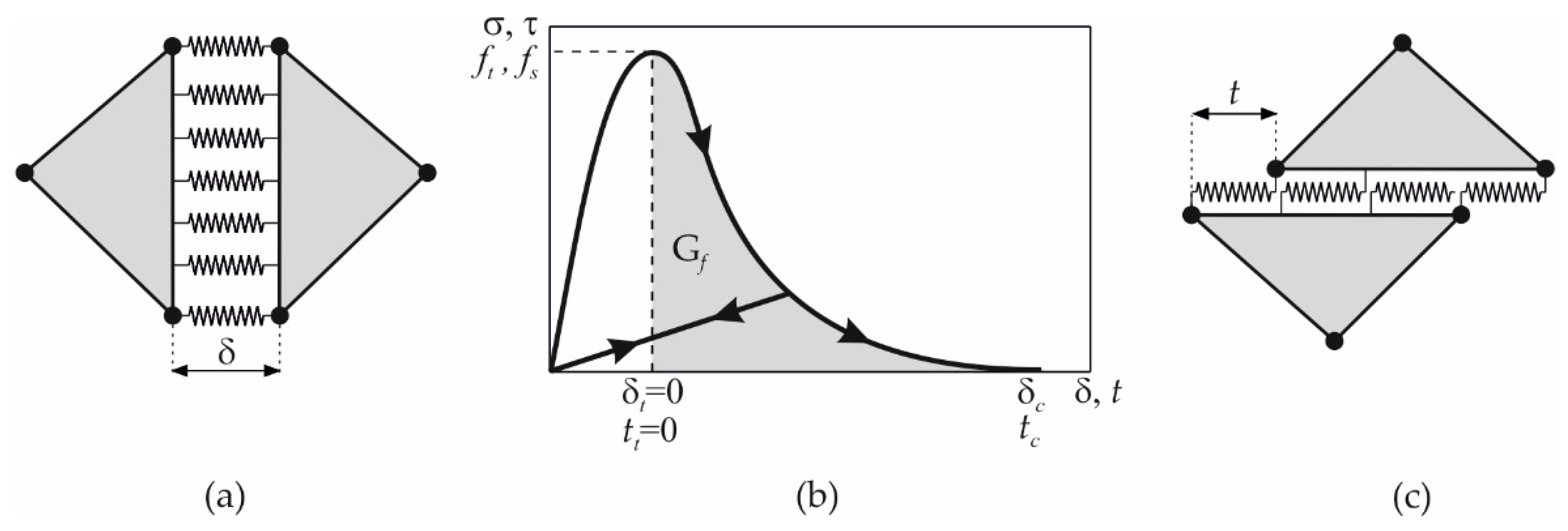
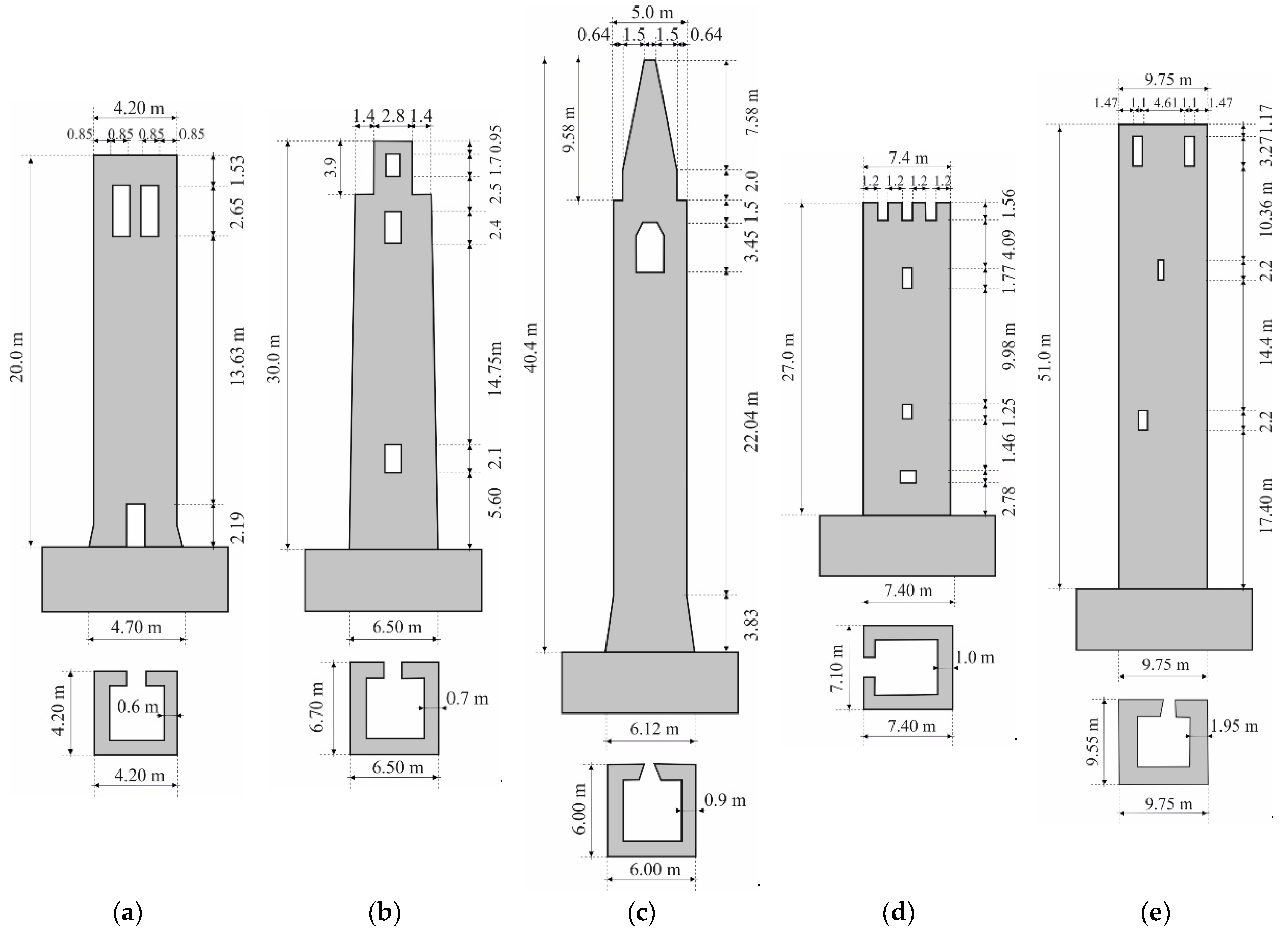
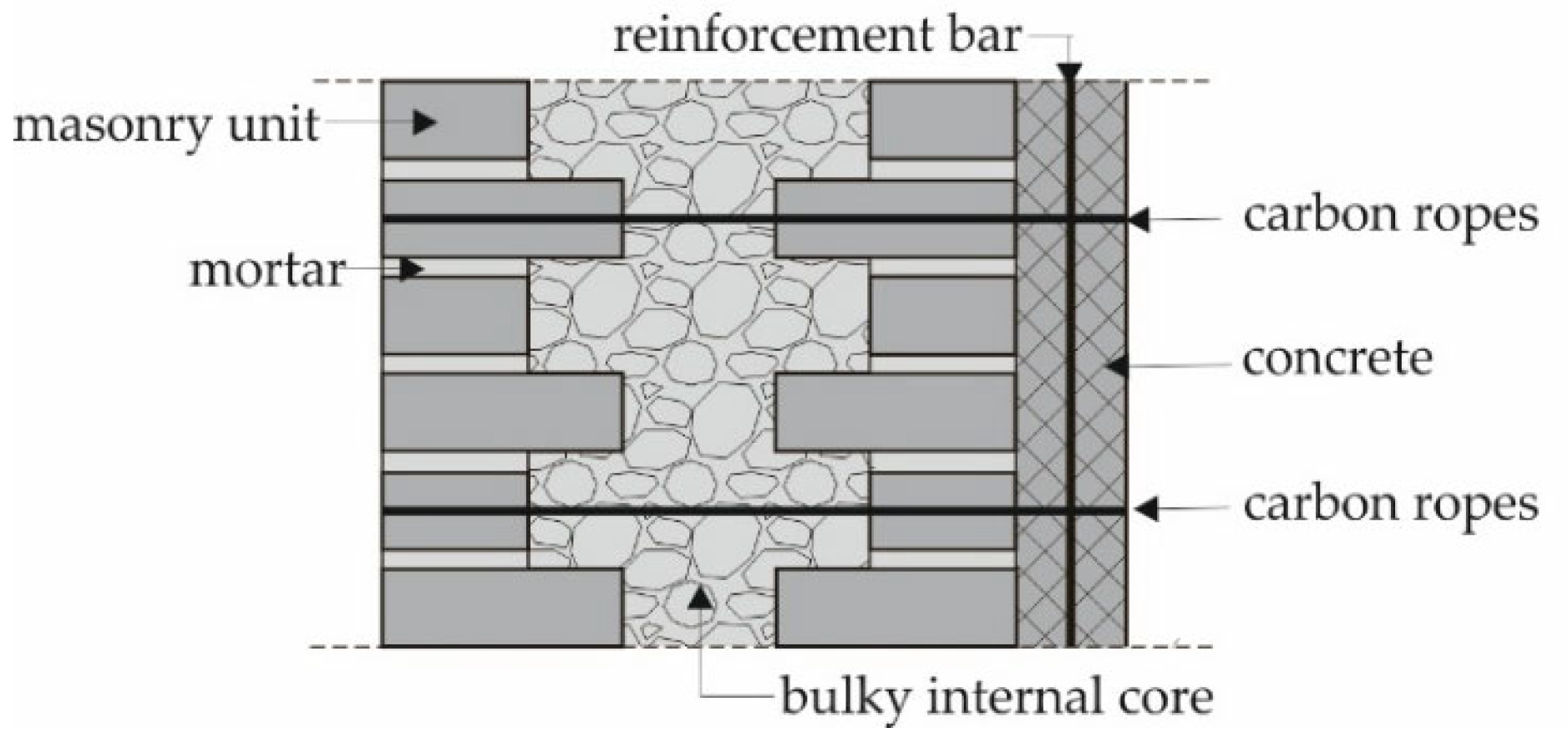





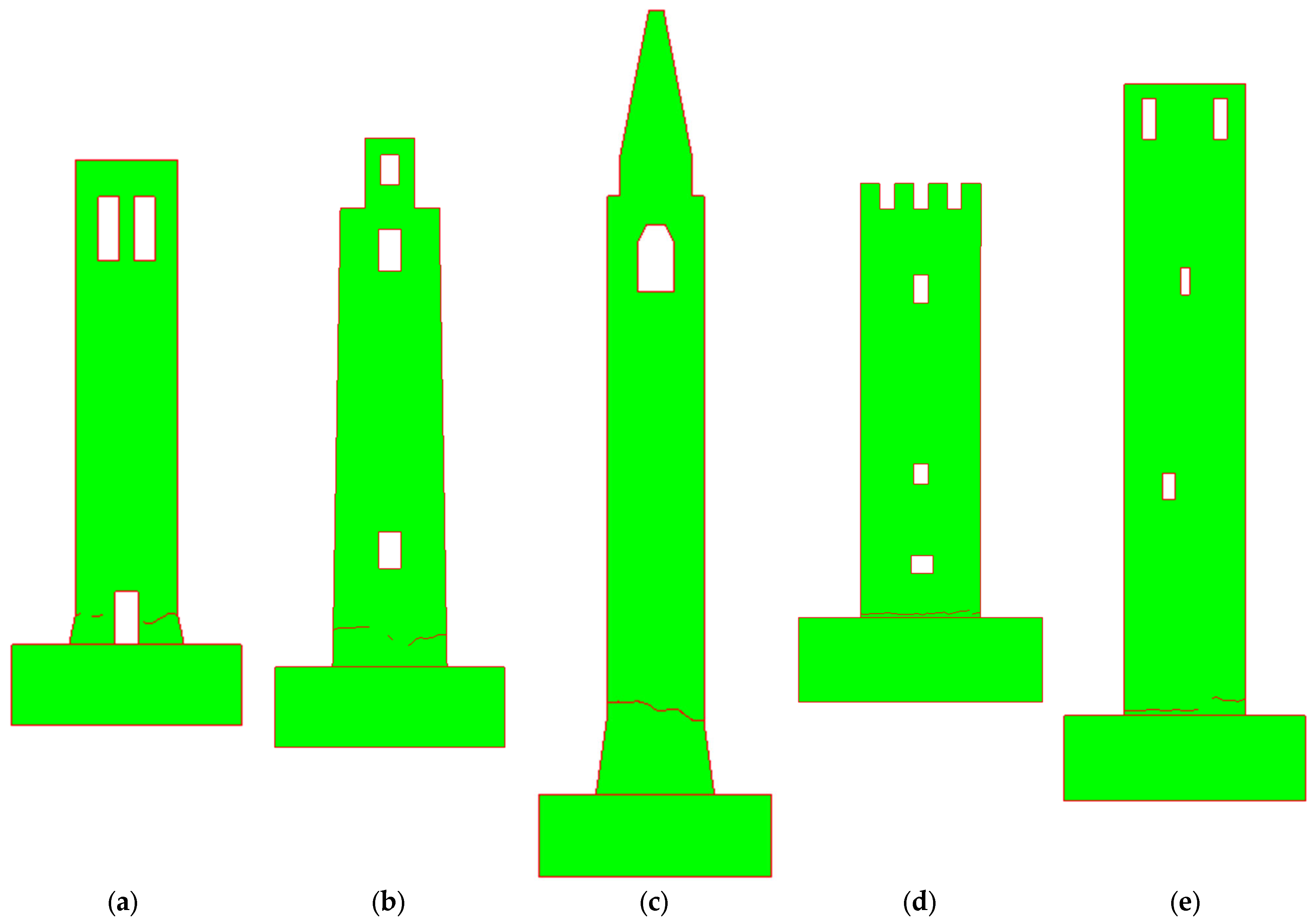

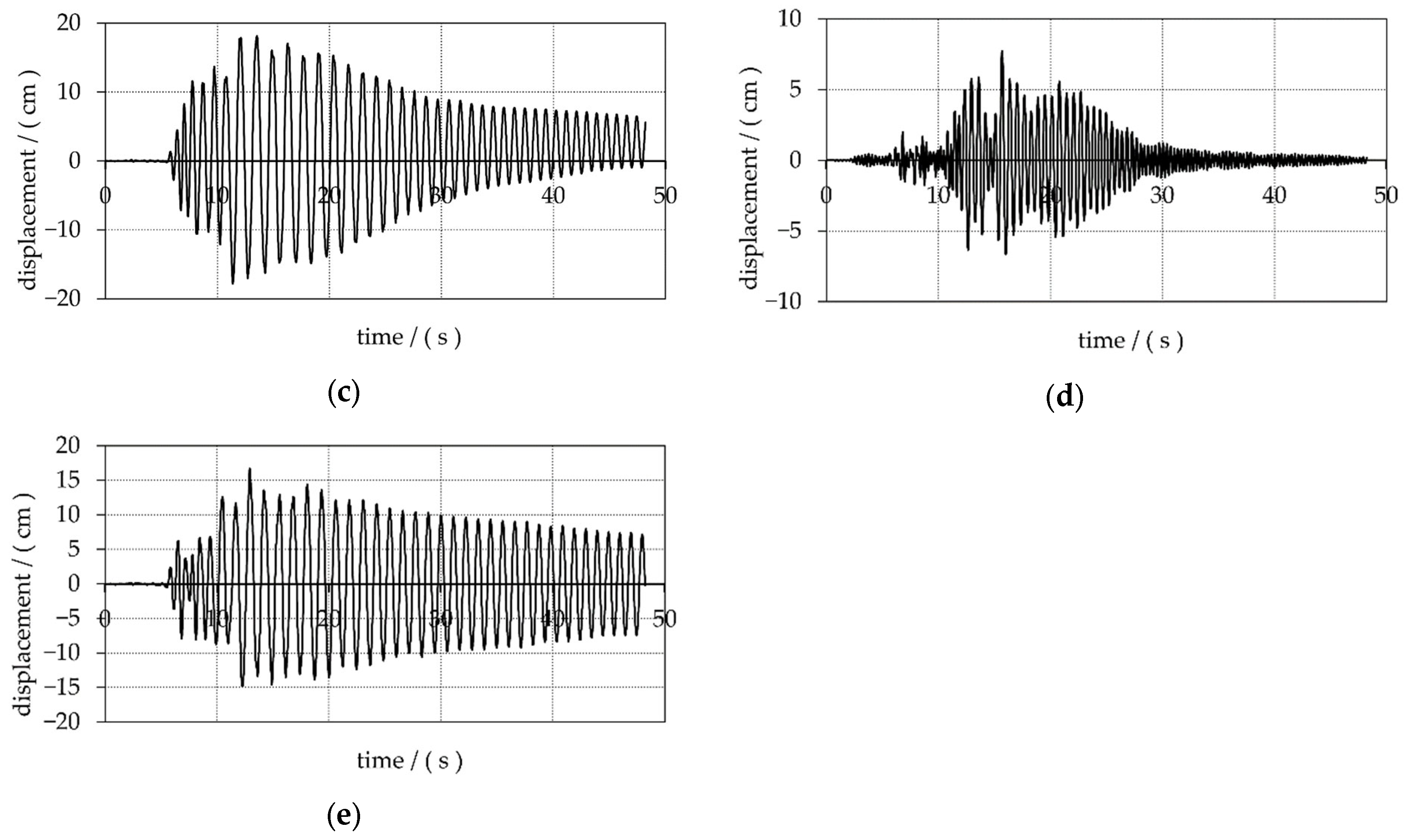


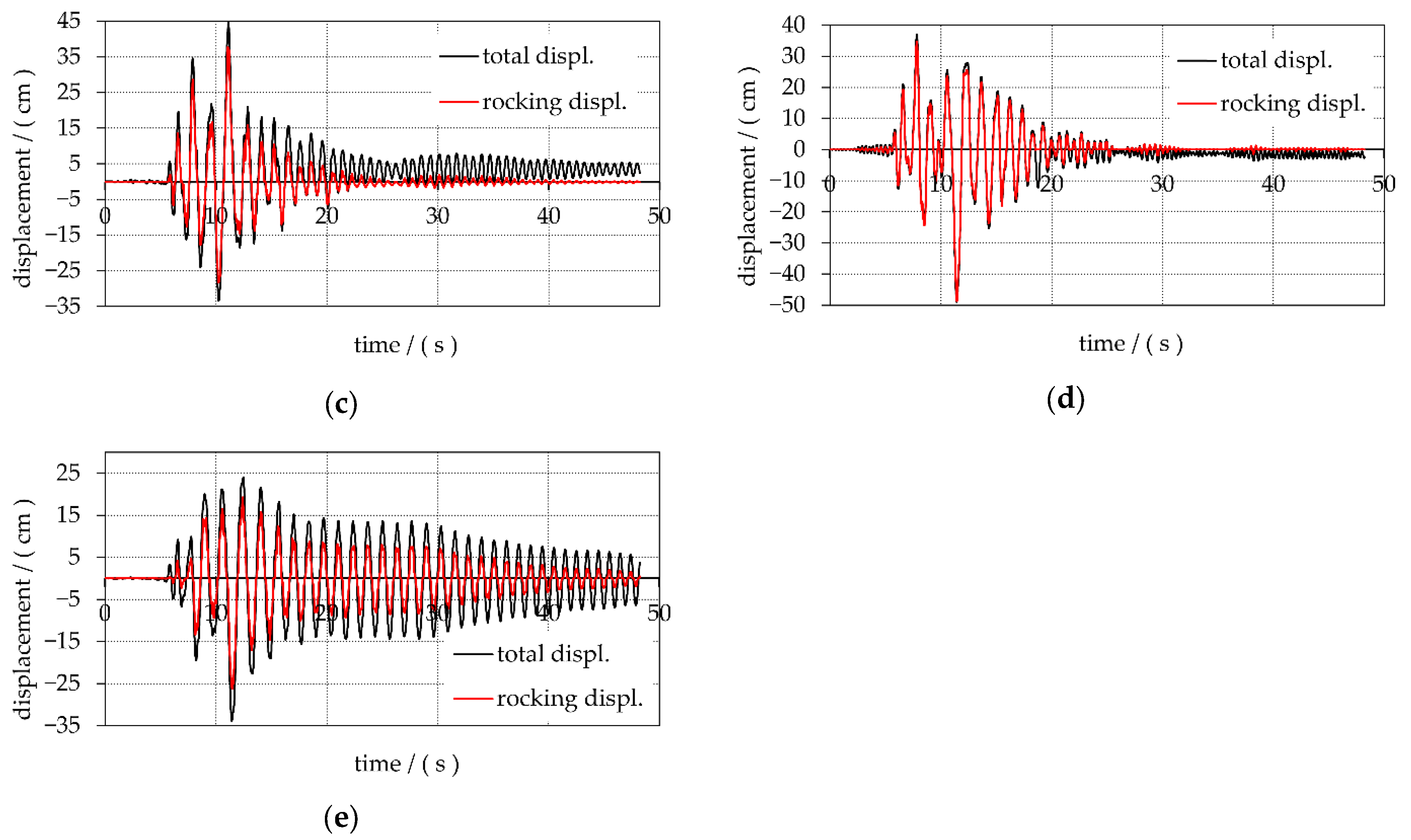
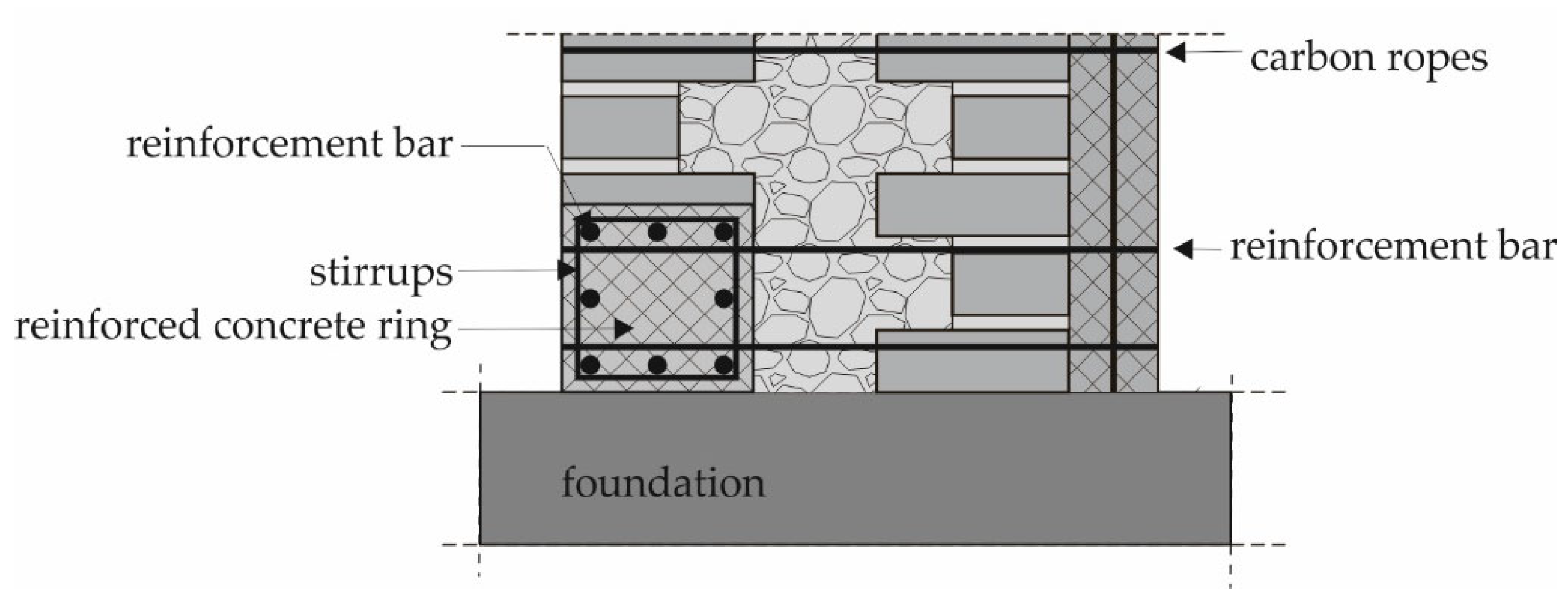
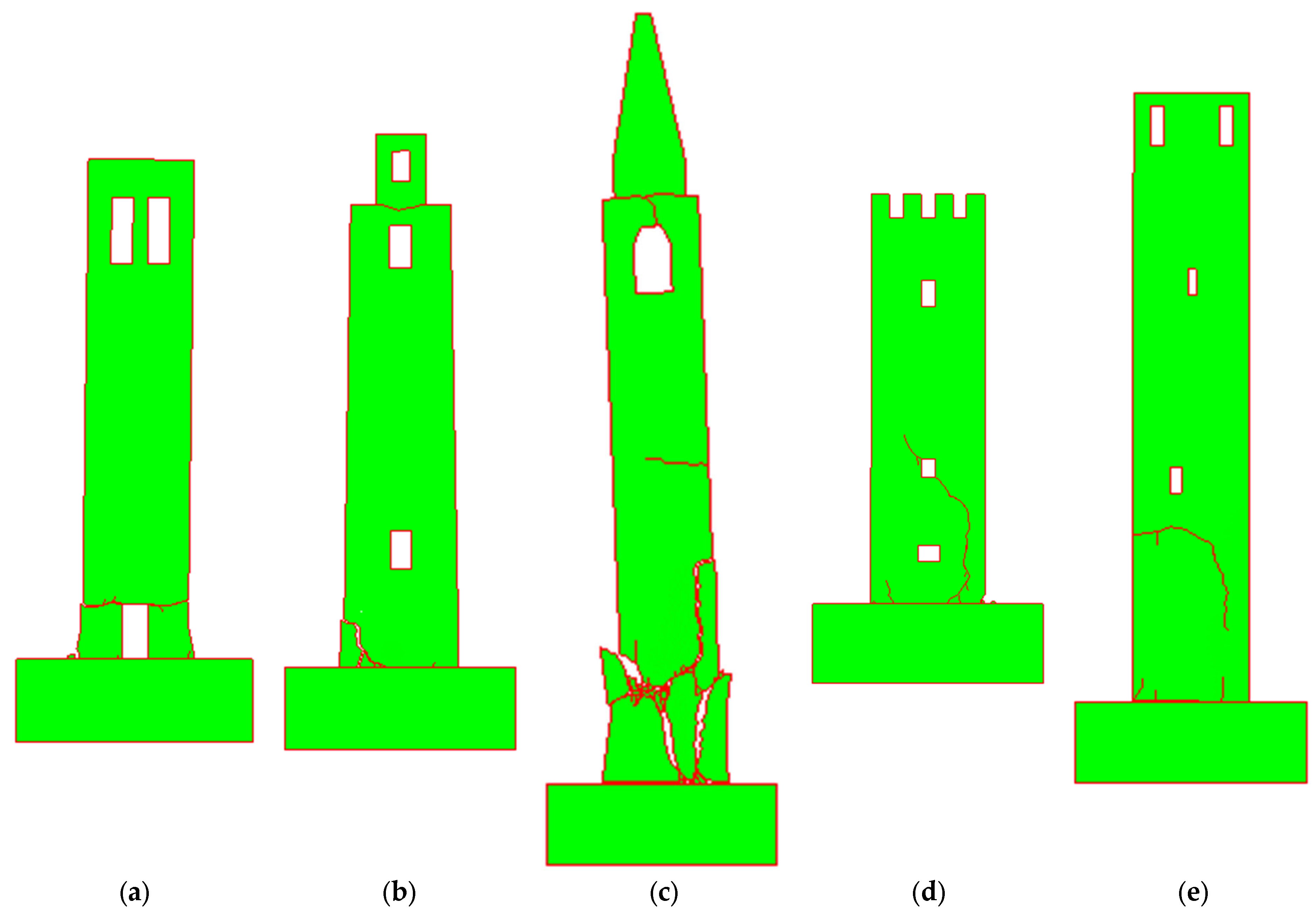
| Tower | A | B | C | D | E |
|---|---|---|---|---|---|
| height of the tower, h/(m) | 20.00 | 30.00 | 40.40 | 27.00 | 51.00 |
| base width of the tower, b/(m) | 4.70 | 6.50 | 6.12 | 7.40 | 9.75 |
| slenderness h/b | 4.25 0.670 | 4.62 | 6.53 | 3.64 | 5.23 |
| Material Properties | |
|---|---|
| Modulus of elasticity, E (MPa) | 2250 |
| Poisson’s ratio, ν | 0.30 0.670 |
| Tensile strength, ft (MPa) | 0.27 |
| Shear strength, fs (MPa) | 1.09 |
| Fracture energy in tension Gf,t (N/m) | 35 |
| Fracture energy in shear Gf,s (N/m) | 140 |
| Friction coefficient, µ | 0.70 |
| Unit mass, ρ (kg/m3) | 1700 |
| Material Properties | Concrete | Steel |
|---|---|---|
| Modulus of elasticity, E (MPa) | 33,000 | 210,000 |
| Poisson’s ratio, ν | 0.20 0.670 | 0.20 |
| Tensile strength, ft (MPa) | 3.00 | 560 |
| Shear strength, fs (MPa) | 12.0 | 392 |
| Fracture energy in tension Gf,t (N/m) | 400 | 2,300,000 |
| Fracture energy in shear Gf,s (N/m) | 1600 | 1,610,000 |
| Friction coefficient, µ | 0.70 | 0.70 |
| Unit mass, ρ (kg/m3) | 2500 | 7850 |
| Material Properties | |
|---|---|
| Modulus of elasticity, E (MPa) | 6625 |
| Poisson’s ratio, ν | 0.3 0.670 |
| Tensile strength, ft (MPa) | 1.17 |
| Shear strength, fs (MPa) | 2.89 |
| Fracture energy in tension Gf,t (N/m) | 2340 |
| Fracture energy in shear Gf,s (N/m) | 1910 |
| Friction coefficient, µ | 0.70 |
| Unit mass, ρ (kg/m3) | 1800 |
| Boundary Condition/Tower | A | B | C | D | E |
|---|---|---|---|---|---|
| fixed to the base, ag,max/(g) | 0.30 0.670 | 0.25 | 0.15 | 0.25 | 0.25 |
| resting freely on the base, ag,max/(g) | 0.70 | 0.70 | 0.60 | 0.90 | 0.35 |
| ag,max (resting freely)/ag,max (fix to the base) | 2.3 | 2.8 | 4.0 | 3.6 | 1.4 |
| Tower | A | B | C | D | E |
|---|---|---|---|---|---|
| max. total displacement, δmax/(cm) | 51.3 0.670 | 32.6 | 45.0 | 49.0 | 33.9 |
| (δmax/h) 100 | 2.57 | 1.09 | 1.11 | 1.81 | 0.66 |
| max. rocking displacement, δr,max/(cm) | 47.6 | 29.8 | 37.8 | 44.8 | 26.2 |
| (δr,max/h) 100 | 2.38 | 0.99 | 0.94 | 1.66 | 0.51 |
| (δr,max/δmax)·100 | 93 | 91 | 84 | 91 | 77 |
| limit rocking displ., δr,lim/(cm) | 470 | 650 | 612 | 740 | 975 |
| (δr,max/δr,lim)·100 | 10.1 | 4.5 | 6.2 | 6.0 | 2.6 |
| Tower | A | B | C | D | E |
|---|---|---|---|---|---|
| weight of the tower, W/(MN) | 3.11 | 8.19 | 11.57 | 12.44 | 55.85 |
| width of the base/(m) | 4.2 | 6.5 | 6.0 | 7.4 | 9.75 |
| contact stress/(MPa) | 7.40 | 12.6 | 19.28 | 16.81 | 57.2 |
Disclaimer/Publisher’s Note: The statements, opinions and data contained in all publications are solely those of the individual author(s) and contributor(s) and not of MDPI and/or the editor(s). MDPI and/or the editor(s) disclaim responsibility for any injury to people or property resulting from any ideas, methods, instructions or products referred to in the content. |
© 2025 by the authors. Licensee MDPI, Basel, Switzerland. This article is an open access article distributed under the terms and conditions of the Creative Commons Attribution (CC BY) license (https://creativecommons.org/licenses/by/4.0/).
Share and Cite
Smoljanović, H.; Balić, I.; Živaljić, N.; Trogrlić, B.; Munjiza, A. The Influence of Boundary Conditions on the Seismic Resistance of Retrofitted Ancient Masonry Towers. Buildings 2025, 15, 2495. https://doi.org/10.3390/buildings15142495
Smoljanović H, Balić I, Živaljić N, Trogrlić B, Munjiza A. The Influence of Boundary Conditions on the Seismic Resistance of Retrofitted Ancient Masonry Towers. Buildings. 2025; 15(14):2495. https://doi.org/10.3390/buildings15142495
Chicago/Turabian StyleSmoljanović, Hrvoje, Ivan Balić, Nikolina Živaljić, Boris Trogrlić, and Ante Munjiza. 2025. "The Influence of Boundary Conditions on the Seismic Resistance of Retrofitted Ancient Masonry Towers" Buildings 15, no. 14: 2495. https://doi.org/10.3390/buildings15142495
APA StyleSmoljanović, H., Balić, I., Živaljić, N., Trogrlić, B., & Munjiza, A. (2025). The Influence of Boundary Conditions on the Seismic Resistance of Retrofitted Ancient Masonry Towers. Buildings, 15(14), 2495. https://doi.org/10.3390/buildings15142495










